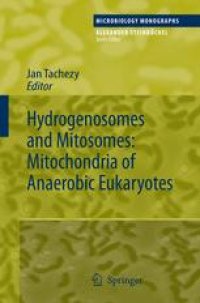
Ebook: Hydrogenosomes and Mitosomes: Mitochondria of Anaerobic Eukaryotes
- Tags: Eukaryotic Microbiology, Cell Biology, Biochemistry general, Evolutionary Biology
- Series: Microbiology Monographs 9
- Year: 2008
- Publisher: Springer-Verlag Berlin Heidelberg
- Edition: 1
- Language: English
- pdf
"Hydrogenosomes and Mitosomes: Mitochondria of Anaerobic Eukaryotes" provides a summary of the current knowledge of these organelles, which occur in unicellular, often parasitic organisms, including human pathogens. The distribution of these organelles is broad, but they were detected primarily in an anoxic habitat or nutrient rich intracellular niche that permits life without the efficient energy generating system of typical mitochondria. Their common characteristic is that they lack the aerobic energy conservation system of typical mitochondria and that they are usually the site of the synthesis of iron-sulfur clusters, regarded as the only indispensable function of eukaryotic mitochondria.
These mitochondria-related organelles exhibit a variety of structures and functions. This work describes properties such as protein import, structure, metabolism, adaptation, proteome and their role in drug activation and resistance. Further topics include the evolution and biogenesis of these organelles.
"Hydrogenosomes and Mitosomes: Mitochondria of Anaerobic Eukaryotes" provides a summary of the current knowledge of these organelles, which occur in unicellular, often parasitic organisms, including human pathogens. The distribution of these organelles is broad, but they were detected primarily in an anoxic habitat or nutrient rich intracellular niche that permits life without the efficient energy generating system of typical mitochondria. Their common characteristic is that they lack the aerobic energy conservation system of typical mitochondria and that they are usually the site of the synthesis of iron-sulfur clusters, regarded as the only indispensable function of eukaryotic mitochondria.
These mitochondria-related organelles exhibit a variety of structures and functions. This work describes properties such as protein import, structure, metabolism, adaptation, proteome and their role in drug activation and resistance. Further topics include the evolution and biogenesis of these organelles.
"Hydrogenosomes and Mitosomes: Mitochondria of Anaerobic Eukaryotes" provides a summary of the current knowledge of these organelles, which occur in unicellular, often parasitic organisms, including human pathogens. The distribution of these organelles is broad, but they were detected primarily in an anoxic habitat or nutrient rich intracellular niche that permits life without the efficient energy generating system of typical mitochondria. Their common characteristic is that they lack the aerobic energy conservation system of typical mitochondria and that they are usually the site of the synthesis of iron-sulfur clusters, regarded as the only indispensable function of eukaryotic mitochondria.
These mitochondria-related organelles exhibit a variety of structures and functions. This work describes properties such as protein import, structure, metabolism, adaptation, proteome and their role in drug activation and resistance. Further topics include the evolution and biogenesis of these organelles.
Content:
Front Matter....Pages I-XII
Anaerobic Eukaryotes in Pursuit of Phylogenetic Normality: the Evolution of Hydrogenosomes and Mitosomes....Pages 1-20
Protein Import into Hydrogenosomes and Mitosomes....Pages 21-73
Structure of the Hydrogenosome....Pages 75-96
Hydrogenosomes of Anaerobic Ciliates....Pages 97-112
Metabolism of Trichomonad Hydrogenosomes....Pages 113-145
Hydrogenosomes of Anaerobic Chytrids: An Alternative Way to Adapt to Anaerobic Environments....Pages 147-162
The Proteome of T. vaginalis Hydrogenosomes....Pages 163-178
Hydrogenosome: The Site of 5-Nitroimidazole Activation and Resistance....Pages 179-199
Mitosomes in Parasitic Protists....Pages 201-230
The Mitochondrion-Related Organelle of Cryptosporidium parvum ....Pages 231-253
Mitochondrial Remnant in Blastocystis....Pages 255-264
Possible Mitochondria-Related Organelles in Poorly-Studied “Amitochondriate” Eukaryotes....Pages 265-282
Back Matter....Pages 283-287
"Hydrogenosomes and Mitosomes: Mitochondria of Anaerobic Eukaryotes" provides a summary of the current knowledge of these organelles, which occur in unicellular, often parasitic organisms, including human pathogens. The distribution of these organelles is broad, but they were detected primarily in an anoxic habitat or nutrient rich intracellular niche that permits life without the efficient energy generating system of typical mitochondria. Their common characteristic is that they lack the aerobic energy conservation system of typical mitochondria and that they are usually the site of the synthesis of iron-sulfur clusters, regarded as the only indispensable function of eukaryotic mitochondria.
These mitochondria-related organelles exhibit a variety of structures and functions. This work describes properties such as protein import, structure, metabolism, adaptation, proteome and their role in drug activation and resistance. Further topics include the evolution and biogenesis of these organelles.
Content:
Front Matter....Pages I-XII
Anaerobic Eukaryotes in Pursuit of Phylogenetic Normality: the Evolution of Hydrogenosomes and Mitosomes....Pages 1-20
Protein Import into Hydrogenosomes and Mitosomes....Pages 21-73
Structure of the Hydrogenosome....Pages 75-96
Hydrogenosomes of Anaerobic Ciliates....Pages 97-112
Metabolism of Trichomonad Hydrogenosomes....Pages 113-145
Hydrogenosomes of Anaerobic Chytrids: An Alternative Way to Adapt to Anaerobic Environments....Pages 147-162
The Proteome of T. vaginalis Hydrogenosomes....Pages 163-178
Hydrogenosome: The Site of 5-Nitroimidazole Activation and Resistance....Pages 179-199
Mitosomes in Parasitic Protists....Pages 201-230
The Mitochondrion-Related Organelle of Cryptosporidium parvum ....Pages 231-253
Mitochondrial Remnant in Blastocystis....Pages 255-264
Possible Mitochondria-Related Organelles in Poorly-Studied “Amitochondriate” Eukaryotes....Pages 265-282
Back Matter....Pages 283-287
....